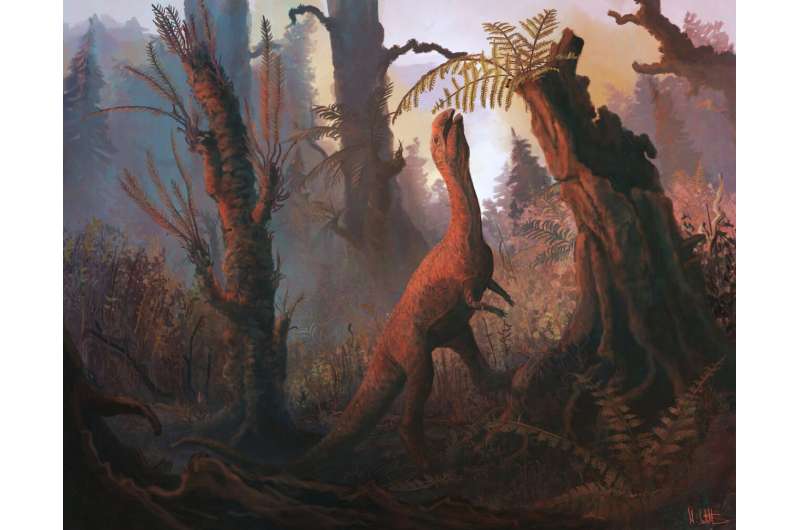Nibbling prehistoric herbivore sheds new light on Triassic diversity

A Triassic herbivore, known for its supposed similarities to a modern-day ostrich, has been revealed to have entirely different approach to feeding from previously thought, according to research at the University of Birmingham.
The new discovery reveals a much broader diversity of herbivore behavior during the Triassic period than has been recognized to date.
Called Effigia, the animal was about the size of a gazelle and lived in North America around 205 million years ago. Its fossil remains were found in the Ghost Ranch Quarry in New Mexico in the 1940s, although the material was not formally described by paleontologists until 2006.
The remains had been relatively poorly preserved in the quarry and the skull, in particular, was quite badly deformed, making accurate reconstruction problematic. Early analysis of the specimen concluded that it belonged to the group of reptiles that includes crocodylians and birds and which started to flourish in the Triassic period.
Although more closely related to crocodylians, Effigia's lightweight body, elongated neck, large eyes and beak shared many similarities with a modern-day ostrich, leading researchers to believe the animal fed by pecking plant material from the ground.
But new analysis of the specimen, by experts at the University of Birmingham, has revealed this animal was probably an entirely different type of herbivore than previously thought. The work, carried out in partnership with experts at the University of Bristol, University College London, University of York, Virginia Tech and the Natural History Museum, is published in The Anatomical Record.
The team used new CT scans of Effigia's skull which revealed a much more accurate reconstruction of the animal. This included new information about the shape of the skull, such as a more rounded, bulbous brain cavity and curved upper and lower jaws. Unlike an ostrich bill, which is more rounded, Effigia's bill is more concave with jaws that open and close a bit like a pair of shears.
The team used this information to model the effects of different forces acting on the skull, including what happens when the animal pecks at the ground. By modeling the forces the skull would need to withstand in order to feed by pecking, the researchers calculated that Effigia's skull would probably have shattered. Instead, they suggest, the animal would be more likely to use its jaws to snip off and nibble pieces of soft plant material such as young shoots, or ferns.
Lead researcher, Dr. Jordan Bestwick, said: "The herbivores we already recognize in the Triassic period fed either by digging for roots, such as the pig-like aetosaurs, or reaching for leaves high up in the treetops, like the long-necked sauropods. These two-legged browsers with a weak bite are unique to this period and show a previously unrecognized diversity among the herbivores of this period."
More information: Jordan Bestwick et al, Cranial functional morphology of the pseudosuchian Effigia and implications for its ecological role in the Triassic, The Anatomical Record (2021). DOI: 10.1002/ar.24827
Provided by University of Birmingham





















